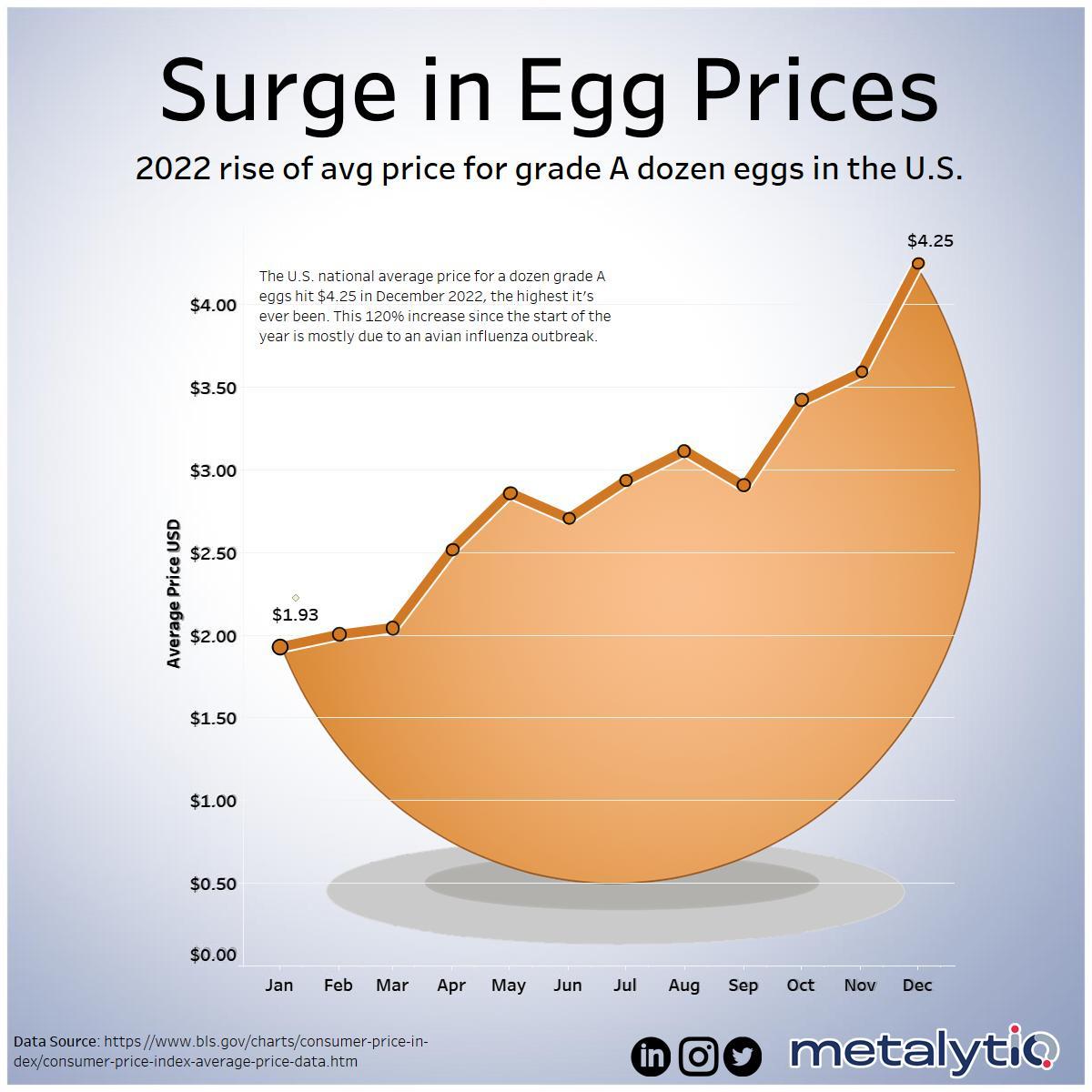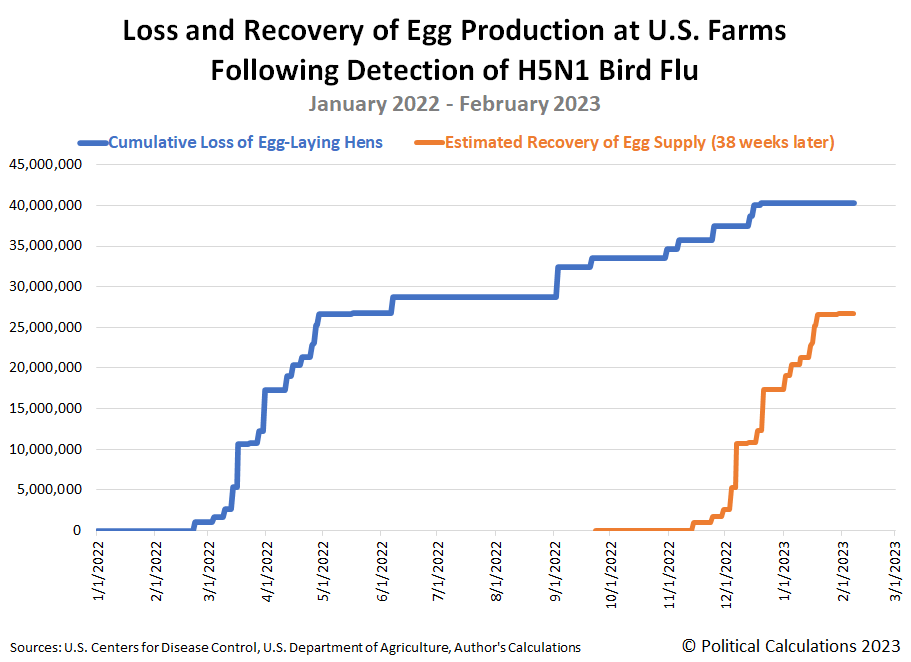When Will The Inflating Price Of Eggs Break?
Consumer price inflation came in hotter than expected in January 2023. While the rate of inflation has moderated since peaking at 9.1% in June 2022, the prices of many goods are still rising quite rapidly. Especially eggs, whose price rise during 2022 was illustrated very well by metalytIQ:

If metalytIQ's chart extended into January 2023, it would show the average price for a dozen Grade A eggs in the U.S. rising to $4.83. Since eggs represent one of the least expensive and most popular sources of protein for Americans, that's a very big deal.
Unlike most products affected by President Biden's COVID-stimulus fueled-inflation, the rising price of eggs has been driven by a devastating tragedy. The spread of H5N1 Highly Pathogenic Avian Influenza (a.k.a. the 2022 bird flu) has led the culling of over 58 million birds in the U.S., including over 40 million table egg-laying hens at commercial farms.
That's nearly one out of eight of the U.S. estimated population of 323 million table egg-laying population of chickens in January 2022. That may sound like much, but eggs are a food product with very few acceptable substitutes, so demand for eggs has remained elevated, even though the supply has shrunk considerably. Since the prices for goods like eggs are set at the margin, that combination of demand and supply has produced an outsized increase in the price consumers pay for eggs.
How much longer might that last?
Since a negative change in supply produced such a large increase in the price of eggs, it stands to reason that a positive change in supply can reverse it. If we know how long it might take the commerical table-egg producing farms to recover from the loss of their flocks, we can project when the rising price of eggs might break.
We tapped a number of sources to put together the following basic timetable for resuming full egg production after an outbreak of the H5N1 influenza virus has been detected in a farm's population of chickens.
- Day 0: Viral infection is detected within a farm's flock.
- Day 1: The entire farm's flock is culled.
- Week 1: The disinfection of the farm's facilities is completed.
- Week 4: The farm's facilities have tested clear of infection for a full three weeks.
- Weeks 4-8: A new population of chicks is introduced.
- Week 30: The first small eggs start being laid.
- Week 36: Eggs being laid reach their "full" size for commercial production.
- Week 38: Hens reach their peak frequency for laying eggs.
Now, we've taken the CDC's data for when the H5N1 bird flu was first detected at commercial table-egg producing farms during 2022 and have projected when the recovery in supply would occur if all goes according to that timetable. The following chart shows the results:
Based on that 38 week recovery time, our back of the envelope timetable would predict that the egg supply would begin recovering in early December 2022, with a fairly robust recovery through January 2023. That scenario would coincide with the commercial farms that were first to be negatively impacted by the 2022 bird flu coming back online after repopulating their egg-laying flocks.
We can check the our egg supply recovery projection using wholesale egg prices, or rather, the prices paid by the firms in between the farms and grocery store consumers. For that data, we pulled the Urner Barry Egg Index shortly after it was updated through 13 February 2023:
Note the wholesale price of eggs starts spiking upward beginning in March 2022, just after the first major outbreaks of H5N1 bird flu at several large commercial egg-producing farms. Flashing forward, we see the wholesale prices of eggs in the U.S. peaked on 19 December 2023, which is close but is some 2 to 3 weeks after our timetable would predict. Since 19 December 2023, the wholesale price of a dozen eggs has dropped from $4.63 to $1.91 as of 13 February 2023.
The price of eggs tracked in the Consumer Price Index for January 2023 is based on prices that applied during the week of 12 January 2023. Assuming a lag of about four weeks for changes in wholesale prices to impact retail prices, we think it's quite possible January 2023 saw the peak in the retail price of eggs for American grocery shoppers. As you're reading this, the rising price of eggs has most likely already broken, with lower egg prices soon to show up at your local grocery store if they haven't already.
References
U.S. Bureau of Labor Statistics. Graphics for Economic News Releases. Average price data (in U.S. dollars), selected items (Eggs, grade A, large, per doz.). [Online Application]. Accessed 14 February 2023.
U.S. Centers for Disease Control. H5N1 Bird Flu Detections across the United States (Backyard and Commercial). Data Table. [CSV Data]. Accessed 14 February 2023.
Urner Barry. Urner Barry Egg Index. [Online Application]. 13 February 2023. Accessed 13 February 2023.
Previously on Political Calculation
Believe it or not, we have covered the economic effects of bird flu on agricultural goods before! Here's a sampling of that coverage in chronological order, which mainly focuses on the impact of 2015's bird flu epidemic on U.S. farm-raised turkeys:
- No, the U.S. Has Not Hit "Peak Turkey" (2015)
- Almost the Year Without Enough Turkey for Thanksgiving (2016, discussing 2015)
- Turkey Shrinkflation (2022)
More By This Author:
Is The S&P 500 Running Hot Or Are Other Factors At Work?Continued Collapse Of U.S. Imports From China Materialized As Expected In December 2022
The Bigger Picture For Housing Affordability In The U.S.
Disclosure: Materials that are published by Political Calculations can provide visitors with free information and insights regarding the incentives created by the laws and policies described. ...
more




